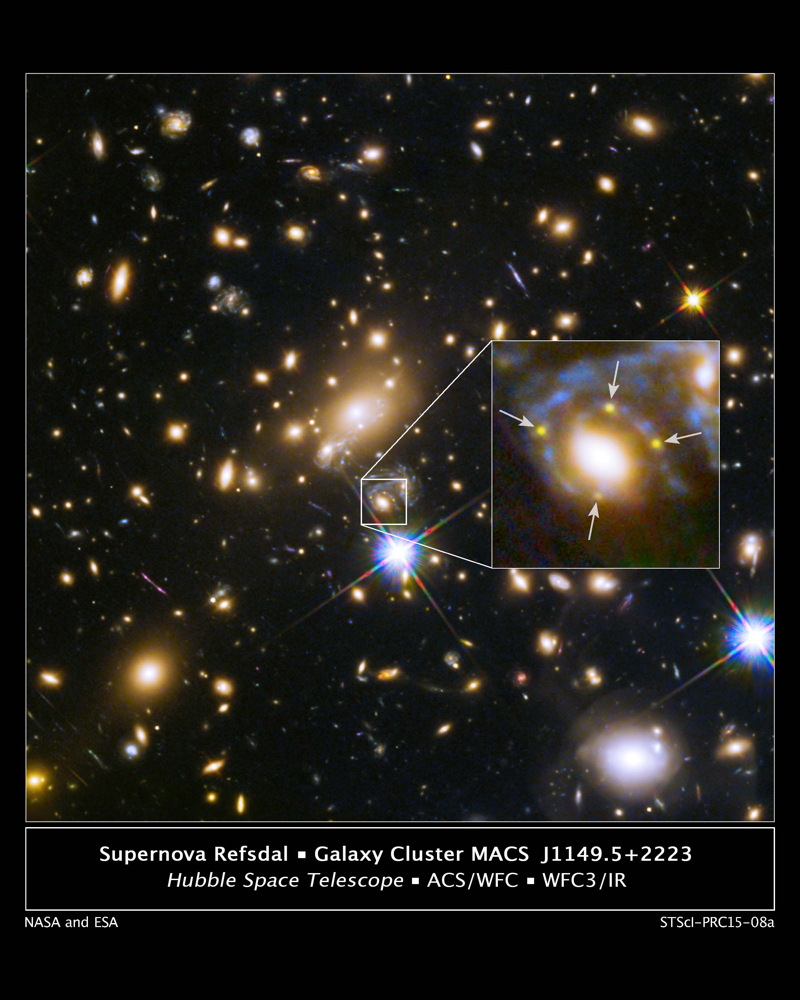Cosmic Lens Reveals 4 Views of Same Star Explosion (Photo)

For the first time, a cosmic magnifying glass has allowed scientists to see the same star explosion four times, possibly offering a revealing glimpse into these explosive stellar deaths and the nature of the accelerating universe.
Astronomers using the Hubble Space Telescope have captured four images of a supernova explosion in deep space thanks to a galaxy located between Earth and the massive star explosion. You can see how Hubble saw the supernova in this NASA video. The galaxy cluster warped the fabric of space and time around it — like a bowling ball placed on a bed sheet — allowing scientists to see the supernova in four images.
"It was predicted 50 years ago that a supernova could be gravitationally lensed like this, but it's taken a long time for someone to find an example," lead study author Patrick Kelly, an astronomer at the University of California, Berkeley told Space.com. "It's fun to have been able to find the first one." [See more amazing supernova photos]
The supernova, which was discovered on Nov. 11, 2014, is located about 9.3 billion light-years away from Earth, near the edge of the observable universe. The researchers have named the distant supernova SN Refsdal in honor of the late Norwegian astrophysicist Sjur Refsdal, a pioneer of gravitational lensing studies. Due to gravitational lensing, "the supernova appears 20 times brighter than its normal brightness," study co-author Jens Hjorth, head of the Dark Cosmology Centre at the Niels Bohr Institute at the University of Copenhagen, said in a statement.
The lensing galaxy, which is about 5 billion light-years from Earth, is part of a large cluster of galaxies known MACS J1149.6+2223. In 2009, astronomers discovered that this cluster was the source of the largest known image of a spiral galaxy ever seen through a gravitational lens.
The four images of the supernova each appeared separately over the course of a few weeks. This is because light can take various paths around and through a gravitational lens, arriving at Earth at different times.
Using gravity as a lens
Gravity is created when matter warps the fabric of reality. The greater the mass of an object, the more space-time curves around that object and the stronger its gravitational pull, the discovery enshrined in Einstein's theory of general relativity, which celebrates its centennial this year.
Get the Space.com Newsletter
Breaking space news, the latest updates on rocket launches, skywatching events and more!
As a result, gravity can also bend light like a lens, meaning objects see n behind powerful gravitational fields, such as those of massive galaxies, are magnified. Gravitational lensing was first discovered in 1979, and today gravitational lenses can help astronomers see features otherwise too distant and faint to detect with even the largest telescopes.
"These gravitational lenses are like a natural magnifying glass. It's like having a much bigger telescope," Kelly said in a statement. "We can get magnifications of up to 100 times by looking through these galaxy clusters."
When light is far from a gravitationally lensing mass, or if the gravitationally lensing mass is not especially large, only "weak lensing" occurs, barely distorting the light. However, when the light comes from almost exactly behind the gravitationally lensing mass, "strong lensing" can happen. [See more photos taken by the Hubble Telescope]
When a strongly lensed object occupies a large patch of space — for instance, if it's a galaxy — it can get smeared into an "Einstein ring" surrounding a gravitationally lensing mass. However, strong lensing of small, pointlike items — for instance, super-bright objects known as quasars — often produces multiple images surrounding the gravitationally lensing mass, resulting in a so-called "Einstein cross."
The observations of SN Refsdal mark the first time astronomers on Earth have witnessed strong lensing of a supernova, with four images of an exploding star arrayed as an Einstein cross.
An expanding universe
These new findings could help scientists measure the accelerating rate at which the universe is expanding, researchers say.
A computer model of the lensing cluster suggests the scientists missed chances to see the lensed supernova 50 and 10 years ago. However, the model also suggests more images of the explosion will repeat again within the next 10 years.
The timing of when all these images of the supernova arrive depends on the gravitational pull of the matter generating the gravitational lens. So, by measuring those times, the researchers hope to map how visible normal matter and invisible dark matter is distributed in the lensing galaxy.
Dark matter is currently one of the greatest mysteries in science, a poorly understood substance thought to make up five-sixths of all matter in the universe. A better understanding of how dark matter is behaving in this gravitationally lensing cluster might help shed light on the material's nature, Kelly said.
Analyzing when the images arrive could also help scientists pinpoint the rate at which the universe is expanding. Although there are already several ways to measure the cosmic expansion rate, "there has been a lot of heated debate between different methods, so it'd be interesting to see how this new technique might affect the area," Kelly said. "It's always nice to have completely independent measurements of the same quantity."
The scientists detailed their findings in the March 6 issue of the journal Science.
Follow us @Spacedotcom, Facebook and Google+. Original article on Space.com.
Join our Space Forums to keep talking space on the latest missions, night sky and more! And if you have a news tip, correction or comment, let us know at: community@space.com.

Charles Q. Choi is a contributing writer for Space.com and Live Science. He covers all things human origins and astronomy as well as physics, animals and general science topics. Charles has a Master of Arts degree from the University of Missouri-Columbia, School of Journalism and a Bachelor of Arts degree from the University of South Florida. Charles has visited every continent on Earth, drinking rancid yak butter tea in Lhasa, snorkeling with sea lions in the Galapagos and even climbing an iceberg in Antarctica. Visit him at http://www.sciwriter.us
